Deck 3: Patterns in Nature: Minerals
Question
Question
Question
Question
Question
Question
Question
Question
Question
Question
Question
Question
Question
Question
Question
Question
Question
Question
Question
Question
Question
Question
Question
Question
Question
Question
Question
Question
Question
Question
Question
Question
Question
Question
Question
Question
Question
Question
Question
Question
Question
Question
Question
Question
Question
Question
Question
Question
Question
Question
Question
Question
Question
Question
Question
Question
Question
Question
Question
Question

Unlock Deck
Sign up to unlock the cards in this deck!
Unlock Deck
Unlock Deck
1/60
Play
Full screen (f)
Deck 3: Patterns in Nature: Minerals
1
Two different minerals may have the same chemical formula.
True
2
Minerals are all naturally occurring solid substances with a definable chemical composition.They must also possess ____________.
A) an ability to be synthesized in the laboratory as well as being found in nature
B) metallic elements, such as iron, calcium, or magnesium
C) metallic luster
D) a fixed crystalline structure (spatial arrangement of atoms and ions)
A) an ability to be synthesized in the laboratory as well as being found in nature
B) metallic elements, such as iron, calcium, or magnesium
C) metallic luster
D) a fixed crystalline structure (spatial arrangement of atoms and ions)
D
3
Two types of bonds that depend upon polarity are ____________ and ____________.
A) hydrogen bonds; van der Waals bonds
B) ionic bonds; covalent bonds
C) hydrogen bonds; metallic bonds
D) ionic bonds; van der Waals bonds
A) hydrogen bonds; van der Waals bonds
B) ionic bonds; covalent bonds
C) hydrogen bonds; metallic bonds
D) ionic bonds; van der Waals bonds
A
4
Which of the following is NOT a mineral?
A) petroleum (oil), which is a liquid
B) cubic zirconia, which is a synthetic diamond substitute that is not found in nature
C) ice, which is water in the solid state
D) Neither a nor b is a mineral; however, c is a mineral.
A) petroleum (oil), which is a liquid
B) cubic zirconia, which is a synthetic diamond substitute that is not found in nature
C) ice, which is water in the solid state
D) Neither a nor b is a mineral; however, c is a mineral.

Unlock Deck
Unlock for access to all 60 flashcards in this deck.
Unlock Deck
k this deck
5
Which common mineral is found in most kitchens?
A) flour
B) sugar
C) halite
D) mustard
A) flour
B) sugar
C) halite
D) mustard

Unlock Deck
Unlock for access to all 60 flashcards in this deck.
Unlock Deck
k this deck
6
Diamond and graphite are both polymorphs of pure silicon.

Unlock Deck
Unlock for access to all 60 flashcards in this deck.
Unlock Deck
k this deck
7
The vast majority of minerals _____________ .
A) are quite common
B) are rare
C) form under special conditions
D) Both a and b are correct.
E) Both b and c are correct.
A) are quite common
B) are rare
C) form under special conditions
D) Both a and b are correct.
E) Both b and c are correct.

Unlock Deck
Unlock for access to all 60 flashcards in this deck.
Unlock Deck
k this deck
8
Natural glass is NOT considered a mineral because it ____________.
A) is not produced by geologic processes
B) is organic
C) does not have an organized crystalline structure
D) can be made synthetically as well as being a naturally occurring substance
A) is not produced by geologic processes
B) is organic
C) does not have an organized crystalline structure
D) can be made synthetically as well as being a naturally occurring substance

Unlock Deck
Unlock for access to all 60 flashcards in this deck.
Unlock Deck
k this deck
9
A single mineral may take on multiple crystalline lattice structures.

Unlock Deck
Unlock for access to all 60 flashcards in this deck.
Unlock Deck
k this deck
10
Minerals utilized by humans as a source of metal are termed ____________. 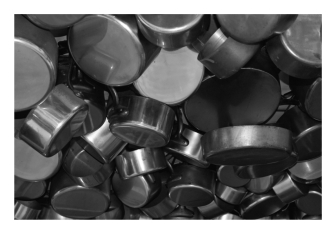
A) metallic minerals
B) ore minerals
C) source minerals

A) metallic minerals
B) ore minerals
C) source minerals

Unlock Deck
Unlock for access to all 60 flashcards in this deck.
Unlock Deck
k this deck
11
In order for glass to be a mineral,which of its properties would need to change?
A) It would need to be crystalline.
B) It would need to have an ordered arrangement of atoms.
C) It would need to be inorganic
D) Both a and b are correct.
E) Both a and c are correct.
A) It would need to be crystalline.
B) It would need to have an ordered arrangement of atoms.
C) It would need to be inorganic
D) Both a and b are correct.
E) Both a and c are correct.

Unlock Deck
Unlock for access to all 60 flashcards in this deck.
Unlock Deck
k this deck
12
Which of the following is NOT a mineral?
A) quartz
B) diamond
C) petroleum
D) gold
A) quartz
B) diamond
C) petroleum
D) gold

Unlock Deck
Unlock for access to all 60 flashcards in this deck.
Unlock Deck
k this deck
13
Minerals in geodes (see below)form spectacular euhedral crystals because ____________. 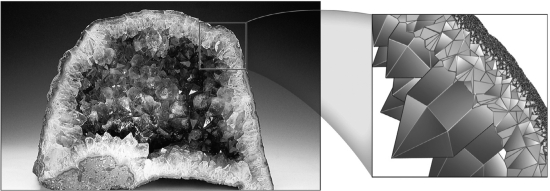
A) all of the elements incorporated in the crystals are in plentiful supply
B) the crystals have abundant room to grow in their hollow surroundings
C) minerals within geodes are always framework silicates
D) minerals within geodes always contain iron

A) all of the elements incorporated in the crystals are in plentiful supply
B) the crystals have abundant room to grow in their hollow surroundings
C) minerals within geodes are always framework silicates
D) minerals within geodes always contain iron

Unlock Deck
Unlock for access to all 60 flashcards in this deck.
Unlock Deck
k this deck
14
All minerals are chemical compounds (composed of more than one element).

Unlock Deck
Unlock for access to all 60 flashcards in this deck.
Unlock Deck
k this deck
15
Five trillion atoms can fit into the head of a pin.Which of the following is in the correct order of smallest to largest? 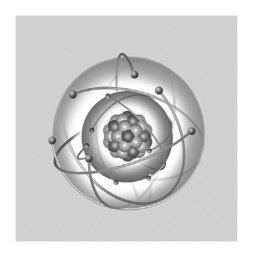
A) atom, nucleus, proton, electron
B) electron, proton, nucleus, atom
C) proton, electron, nucleus, atom
D) atom, electron, nucleus, proton

A) atom, nucleus, proton, electron
B) electron, proton, nucleus, atom
C) proton, electron, nucleus, atom
D) atom, electron, nucleus, proton

Unlock Deck
Unlock for access to all 60 flashcards in this deck.
Unlock Deck
k this deck
16
Minerals play an important role in ________________ .
A) our health
B) our energy use
C) the processing of many products
D) All of the above are correct.
A) our health
B) our energy use
C) the processing of many products
D) All of the above are correct.

Unlock Deck
Unlock for access to all 60 flashcards in this deck.
Unlock Deck
k this deck
17
How is chloride different from chlorine?
A) Chloride is chlorine's anion.
B) Chloride has more electrons than chlorine.
C) Chloride has fewer protons than chlorine.
D) Both a and b are correct.
E) Both a and c are correct.
A) Chloride is chlorine's anion.
B) Chloride has more electrons than chlorine.
C) Chloride has fewer protons than chlorine.
D) Both a and b are correct.
E) Both a and c are correct.

Unlock Deck
Unlock for access to all 60 flashcards in this deck.
Unlock Deck
k this deck
18
All minerals are held together by ionic bonds.

Unlock Deck
Unlock for access to all 60 flashcards in this deck.
Unlock Deck
k this deck
19
The New Age practice of surrounding one's self with crystals has a strong positive effect on ____________.
A) mental health
B) the immune system's response to illness
C) the prospects for world peace
D) the bank accounts of rock shop owners
A) mental health
B) the immune system's response to illness
C) the prospects for world peace
D) the bank accounts of rock shop owners

Unlock Deck
Unlock for access to all 60 flashcards in this deck.
Unlock Deck
k this deck
20
The internal ordering of mineral crystals is detected using ____________.
A) magnetic resonance imaging
B) X-ray diffraction
C) a scanning electron microscope (SEM)
D) cathodized axial tomography
A) magnetic resonance imaging
B) X-ray diffraction
C) a scanning electron microscope (SEM)
D) cathodized axial tomography

Unlock Deck
Unlock for access to all 60 flashcards in this deck.
Unlock Deck
k this deck
21
The shape of a crystal is most affected by all of the following except?
A) geometry of their internal structure
B) the angles between crystal faces
C) chemical composition of its surroundings
D) relative dimensions of the crystal
A) geometry of their internal structure
B) the angles between crystal faces
C) chemical composition of its surroundings
D) relative dimensions of the crystal

Unlock Deck
Unlock for access to all 60 flashcards in this deck.
Unlock Deck
k this deck
22
If you were to drop a piece of calcite on the ground and a perfect cube broke off,this would be displaying calcite breaking ______________.
A) along already formed cracks
B) coincidentally as a perfect cube
C) in a fracture pattern
D) along weak bonds
A) along already formed cracks
B) coincidentally as a perfect cube
C) in a fracture pattern
D) along weak bonds

Unlock Deck
Unlock for access to all 60 flashcards in this deck.
Unlock Deck
k this deck
23
In nature most examples of minerals do NOT grow as large,well-formed,euhedral crystals.

Unlock Deck
Unlock for access to all 60 flashcards in this deck.
Unlock Deck
k this deck
24
The most useful diagnostic property of minerals is their color in a hand sample.

Unlock Deck
Unlock for access to all 60 flashcards in this deck.
Unlock Deck
k this deck
25
Which of the following is NOT a way crystals can form? 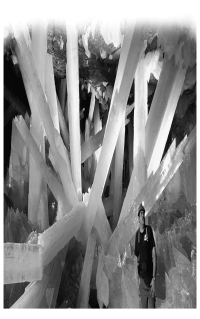
A) solidification of a melt
B) precipitation from solution
C) solid-state diffusion
D) biomineralization
E) All of the above are ways crystals can form.

A) solidification of a melt
B) precipitation from solution
C) solid-state diffusion
D) biomineralization
E) All of the above are ways crystals can form.

Unlock Deck
Unlock for access to all 60 flashcards in this deck.
Unlock Deck
k this deck
26
For the majority of minerals,the streak color obtained when the mineral is scratched against a porcelain plate is ____________. 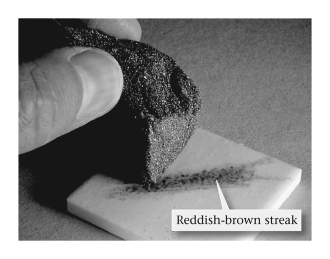
A) likely to be diagnostic only if the mineral is hard enough to scratch porcelain
B) more variable than the color in a hand sample among crystals
C) less variable than the color in a hand sample among crystals
D) always dark brown or black

A) likely to be diagnostic only if the mineral is hard enough to scratch porcelain
B) more variable than the color in a hand sample among crystals
C) less variable than the color in a hand sample among crystals
D) always dark brown or black

Unlock Deck
Unlock for access to all 60 flashcards in this deck.
Unlock Deck
k this deck
27
Minerals that do not possess cleavage are said to possess ____________. 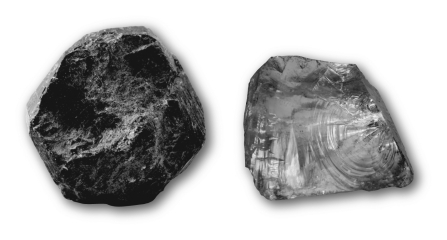
A) invulnerability
B) fracture
C) solidity
D) massiveness

A) invulnerability
B) fracture
C) solidity
D) massiveness

Unlock Deck
Unlock for access to all 60 flashcards in this deck.
Unlock Deck
k this deck
28
Which of the following minerals is hardest?
A) quartz
B) calcite
C) talc
D) fluorite
A) quartz
B) calcite
C) talc
D) fluorite

Unlock Deck
Unlock for access to all 60 flashcards in this deck.
Unlock Deck
k this deck
29
Cleavage in minerals refers to ____________.
A) a tendency to break in an irregular pattern
B) a tendency to break along planes of weakness
C) the sharpness of edges between crystal faces
D) the development of distinct crystal faces
A) a tendency to break in an irregular pattern
B) a tendency to break along planes of weakness
C) the sharpness of edges between crystal faces
D) the development of distinct crystal faces

Unlock Deck
Unlock for access to all 60 flashcards in this deck.
Unlock Deck
k this deck
30
Topaz,with Mohs hardness of 8,is twice as hard as fluorite,with Mohs hardness of 4.

Unlock Deck
Unlock for access to all 60 flashcards in this deck.
Unlock Deck
k this deck
31
The shininess of a mineral is a helpful diagnostic property termed ____________. 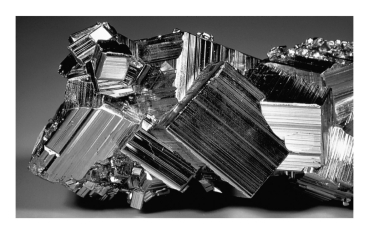
A) color
B) specific gravity
C) luster
D) streak

A) color
B) specific gravity
C) luster
D) streak

Unlock Deck
Unlock for access to all 60 flashcards in this deck.
Unlock Deck
k this deck
32
In order for diamond to become graphite,what would need to occur?
A) The carbon atoms would need to be bonded in sheets.
B) The carbon atoms would need to be bonded in tetrahedra.
C) The bonds would need to weaken.
D) Both a and c are correct.
E) Both b and c are correct.
A) The carbon atoms would need to be bonded in sheets.
B) The carbon atoms would need to be bonded in tetrahedra.
C) The bonds would need to weaken.
D) Both a and c are correct.
E) Both b and c are correct.

Unlock Deck
Unlock for access to all 60 flashcards in this deck.
Unlock Deck
k this deck
33
The color of a mineral in powdered form is termed ____________.
A) color
B) specific gravity
C) luster
D) streak
A) color
B) specific gravity
C) luster
D) streak

Unlock Deck
Unlock for access to all 60 flashcards in this deck.
Unlock Deck
k this deck
34
The ____________ of new solid grains called _____________ results from oversaturated solutions.
A) precipitate; precipitation
B) precipitation; precipitate
A) precipitate; precipitation
B) precipitation; precipitate

Unlock Deck
Unlock for access to all 60 flashcards in this deck.
Unlock Deck
k this deck
35
The single property that can be used to identify any mineral is ____________.
A) color
B) luster
C) cleavage
D) None of the above are correct; multiple properties must be used to diagnose a mineral.
A) color
B) luster
C) cleavage
D) None of the above are correct; multiple properties must be used to diagnose a mineral.

Unlock Deck
Unlock for access to all 60 flashcards in this deck.
Unlock Deck
k this deck
36
The most recently formed portion of any crystal is always found ____________.
A) deep within the interior
B) on the outer edges
A) deep within the interior
B) on the outer edges

Unlock Deck
Unlock for access to all 60 flashcards in this deck.
Unlock Deck
k this deck
37
Trace amounts of impurity in a mineral can commonly produce significant differences in ____________ among individual crystals of this mineral.
A) color
B) specific gravity
C) luster
D) streak
A) color
B) specific gravity
C) luster
D) streak

Unlock Deck
Unlock for access to all 60 flashcards in this deck.
Unlock Deck
k this deck
38
With regard to minerals,hardness refers to ____________.
A) the ability to resist breaking when being struck with a hammer
B) the ability to resist being scratched by other substances
C) the ability to resist chemical reactions with other substances
D) an absence of cleavage
A) the ability to resist breaking when being struck with a hammer
B) the ability to resist being scratched by other substances
C) the ability to resist chemical reactions with other substances
D) an absence of cleavage

Unlock Deck
Unlock for access to all 60 flashcards in this deck.
Unlock Deck
k this deck
39
Minerals can be destroyed by ___________ .
A) melting
B) chemical reactions
C) dissolving
D) All of the above are correct.
A) melting
B) chemical reactions
C) dissolving
D) All of the above are correct.

Unlock Deck
Unlock for access to all 60 flashcards in this deck.
Unlock Deck
k this deck
40
Which of the following minerals is softest?
A) quartz
B) calcite
C) talc
D) fluorite
A) quartz
B) calcite
C) talc
D) fluorite

Unlock Deck
Unlock for access to all 60 flashcards in this deck.
Unlock Deck
k this deck
41
What is not required for the production of diamonds?
A) carbon
B) extreme temperatures and pressures
C) subduction or collision
D) graphite
A) carbon
B) extreme temperatures and pressures
C) subduction or collision
D) graphite

Unlock Deck
Unlock for access to all 60 flashcards in this deck.
Unlock Deck
k this deck
42
Minerals are classified into groups known as mineral classes primarily on a basis of ____________.
A) chemistry, specifically the cations within the chemical formula
B) chemistry, specifically the anions within the chemical formula
C) hardness; hard, soft, and medium are the three primary classes
D) number of cleavage directions present
A) chemistry, specifically the cations within the chemical formula
B) chemistry, specifically the anions within the chemical formula
C) hardness; hard, soft, and medium are the three primary classes
D) number of cleavage directions present

Unlock Deck
Unlock for access to all 60 flashcards in this deck.
Unlock Deck
k this deck
43
Which common gemstone results from biomineralization?
A) diamonds
B) garnets
C) pearls
D) sapphires
A) diamonds
B) garnets
C) pearls
D) sapphires

Unlock Deck
Unlock for access to all 60 flashcards in this deck.
Unlock Deck
k this deck
44
The diamonds we see today do not display their natural crystal faces,but rather ____________,a typical engagement ring bearing 57 of them.
A) faces
B) facets
C) cleavage planes
D) facades
A) faces
B) facets
C) cleavage planes
D) facades

Unlock Deck
Unlock for access to all 60 flashcards in this deck.
Unlock Deck
k this deck
45
Which two gems are special versions of the common mineral corundum (Al₂O₃)?
A) emeralds and rubies
B) emeralds and sapphires
C) aquamarines and emeralds
D) sapphires and rubies
A) emeralds and rubies
B) emeralds and sapphires
C) aquamarines and emeralds
D) sapphires and rubies

Unlock Deck
Unlock for access to all 60 flashcards in this deck.
Unlock Deck
k this deck
46
Ore minerals,such as galena,tend to be distinct in their very ____________.
A) dark coloration
B) diamond-like crystal habit
C) great specific gravity
D) vitreous luster
A) dark coloration
B) diamond-like crystal habit
C) great specific gravity
D) vitreous luster

Unlock Deck
Unlock for access to all 60 flashcards in this deck.
Unlock Deck
k this deck
47
Gemstones are commonly found in pegmatites,which are igneous rocks that are ____________.
A) exceptionally mafic
B) extrusive, forming from lava
C) exceptionally coarse grained
D) exceptionally fine grained
A) exceptionally mafic
B) extrusive, forming from lava
C) exceptionally coarse grained
D) exceptionally fine grained

Unlock Deck
Unlock for access to all 60 flashcards in this deck.
Unlock Deck
k this deck
48
When in contact with hydrochloric acid,which mineral gives off bubbles of carbon dioxide gas? 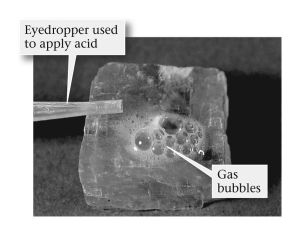
A) quartz
B) halite
C) calcite
D) fluorite

A) quartz
B) halite
C) calcite
D) fluorite

Unlock Deck
Unlock for access to all 60 flashcards in this deck.
Unlock Deck
k this deck
49
The most abundant minerals belong to a chemical group termed the ____________.
A) silicates
B) carbonates
C) halides
D) oxides
A) silicates
B) carbonates
C) halides
D) oxides

Unlock Deck
Unlock for access to all 60 flashcards in this deck.
Unlock Deck
k this deck
50
____________ is a mineral property defined by the density of the mineral sample divided by the density of water (1g/cm³).
A) Color
B) Specific gravity
C) Luster
D) Streak
A) Color
B) Specific gravity
C) Luster
D) Streak

Unlock Deck
Unlock for access to all 60 flashcards in this deck.
Unlock Deck
k this deck
51
In which type of silicate are the greatest proportion of oxygen atoms shared by pairs of adjacent tetrahedra?
A) chain silicates
B) framework silicates
C) sheet silicates
D) Sharing of oxygen atoms does not occur in silicates.
A) chain silicates
B) framework silicates
C) sheet silicates
D) Sharing of oxygen atoms does not occur in silicates.

Unlock Deck
Unlock for access to all 60 flashcards in this deck.
Unlock Deck
k this deck
52
Why might diamonds be found in other locations besides kimberlite pipes?
A) erosion and transportation by rivers
B) transportation by glaciers
C) transportation by the meteorites
D) Both a and b are correct.
E) Both a and c are correct.
A) erosion and transportation by rivers
B) transportation by glaciers
C) transportation by the meteorites
D) Both a and b are correct.
E) Both a and c are correct.

Unlock Deck
Unlock for access to all 60 flashcards in this deck.
Unlock Deck
k this deck
53
Most commercially exploited metals are extracted from the ground as native elements.

Unlock Deck
Unlock for access to all 60 flashcards in this deck.
Unlock Deck
k this deck
54
Silicates form their own mineral class and there are many examples of silicate minerals,most of which look dissimilar to each other.Which of the following does not cause these dissimilarities?
A) the number of oxygen atoms in their internal structure
B) the ratio of silicon and oxygen atoms in their internal structure
C) the way the silica tetrahedra are arranged in their internal structure
D) the environment in which they form
A) the number of oxygen atoms in their internal structure
B) the ratio of silicon and oxygen atoms in their internal structure
C) the way the silica tetrahedra are arranged in their internal structure
D) the environment in which they form

Unlock Deck
Unlock for access to all 60 flashcards in this deck.
Unlock Deck
k this deck
55
If humans were able to see a wider range of wavelengths,which physical property/properties of minerals would be affected?
A) color
B) streak
C) luster
D) Both a and b are correct.
E) Both a and c are correct.
A) color
B) streak
C) luster
D) Both a and b are correct.
E) Both a and c are correct.

Unlock Deck
Unlock for access to all 60 flashcards in this deck.
Unlock Deck
k this deck
56
In silicate minerals,tetrahedra may be linked to form ____________.
A) long one-dimensional chains
B) extensive two-dimensional sheets
C) massive three-dimensional frameworks
D) All of the above are correct.
A) long one-dimensional chains
B) extensive two-dimensional sheets
C) massive three-dimensional frameworks
D) All of the above are correct.

Unlock Deck
Unlock for access to all 60 flashcards in this deck.
Unlock Deck
k this deck
57
Some gemstones are simply prettier versions of common minerals.What makes them special in comparison to their more lackluster versions?
A) their color
B) the way light passes through the mineral
C) the chemical composition of the mineral
D) Both a and b are correct.
E) Both a and c are correct.
A) their color
B) the way light passes through the mineral
C) the chemical composition of the mineral
D) Both a and b are correct.
E) Both a and c are correct.

Unlock Deck
Unlock for access to all 60 flashcards in this deck.
Unlock Deck
k this deck
58
Synthetically made glass and natural quartz crystals both exhibit a fracture pattern termed ____________.
A) glassy
B) conchoidal
C) serpentine
D) obtuse
A) glassy
B) conchoidal
C) serpentine
D) obtuse

Unlock Deck
Unlock for access to all 60 flashcards in this deck.
Unlock Deck
k this deck
59
The silicate tetrahedron that forms the backbone of all the silicate minerals is composed of silicon and what other element?
A) magnesium
B) oxygen
C) iron
D) carbon
A) magnesium
B) oxygen
C) iron
D) carbon

Unlock Deck
Unlock for access to all 60 flashcards in this deck.
Unlock Deck
k this deck
60
Diamonds are usually found in pipes 50 to 200 m across made of _____________. 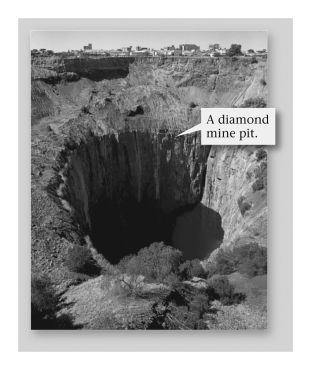
A) kimberlite
B) graphite
C) metamorphic rocks

A) kimberlite
B) graphite
C) metamorphic rocks

Unlock Deck
Unlock for access to all 60 flashcards in this deck.
Unlock Deck
k this deck



